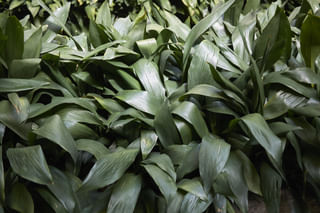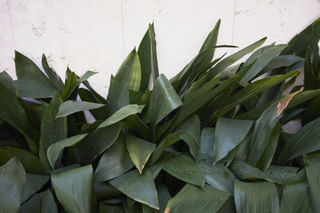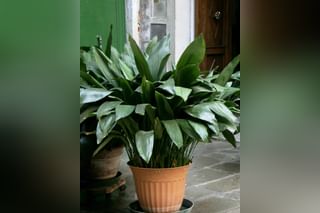How to take care of a Cast Iron Plant (Aspidistra elatior)
In this plant care guide, you'll find everything you need to know to take care of the Cast Iron Plant (Aspidistra elatior). Learn how to water, fertilize, propagate and repot your plant. Keep it healthy with tips on dealing with pests and other issues you might find.

Are you on the hunt for a houseplant that's both attractive and tough? If so, the Cast Iron Plant, also known as Aspidistra elatior or the Bar Room Plant/Ballroom Plant, is the plant for you. This plant is very tough because it can thrive in low-light spots and live for many decades! With proper care, it can look gorgeous in your home or office. In this plant care guide, we'll look at how you can take care of your Cast Iron Plant, so it can stay happy and healthy!
In this plant care guide, we're going to look at these aspects of taking care of a Cast Iron Plant:
Let's get started and see how to take care of this tough plant in your house!
How often should I water a Cast Iron Plant?
Watering your plant properly is one of the most important things to keep it healthy for a long time. You can help your Cast Iron Plant stay healthy by giving it the right amount of water. You should water your plant when the top 2-5 cm (1-2 inches) of soil has dried up. You can check this by sticking your finger in the soil. Check the soil regularly to see if it's dry. If the soil is still damp when you check it, wait a few more days and check again. On average, you should water your plant once every 7-10 days in the summer and once every 10-14 days in the winter.
Don't water it too much
When it comes to taking care of your Cast Iron Plant, make sure you don't give it too much water. Too much moisture can cause root rot and other issues that can damage the plant. Since this plant is sensitive to overwatering, it's important to use a pot with drainage holes.
Drainage holes will help to prevent overwatering your plant. After watering, check that any excess water is draining out of the drainage holes. Let the plant drain for about 5 minutes, and any excess moisture should have drained out of the pot.
It's also important to note that Cast Iron Plants like humid environments, so if your home has low humidity levels, consider misting them occasionally or using a humidity tray filled with pebbles and water beneath their pots (just make sure not to let the pot touch the water). This will help keep their leaves looking vibrant and healthy!
How can I prevent root rot in a Cast Iron Plant?
Root rot can cause a lot of damage on your Cast Iron Plant's root system, making it difficult for the plant to absorb nutrients and water. Preventing root rot is important to make sure your plant stays healthy for many years. You can prevent root rot in a Cast Iron Plant using these methods:
- Proper drainage: Make sure the pot has drainage holes, so any excess moisture can drain from the pot. This helps your plant not stand in a puddle of water.
- Well-draining soil: Use a well-draining potting mix, like a mix of regular potting soil with added perlite or peat moss, to improve drainage.
- Watering practices: Water the plant only when the top inch of the soil feels dry to the touch. Overwatering is a common cause of root rot, so it's important to let the soil dry out between waterings.
- Pot size: Choose a pot that's the right size for your plant. A pot that's too large can hold too much water, while a pot that's too small can restrict root growth and lead to poor drainage.
- Avoid standing water: Never let the plant sit in standing water. After watering, empty any excess water from the saucer beneath the pot.
- Air circulation: Good air circulation around the plant helps to dry out the soil more quickly and lowers the humidity levels slightly. This makes it a difficult place for root rot to start to happen.
You can use any of these methods to lower the chance of getting root rot. Ideally, you should implement all of these methods, because this will keep your plant healthy for a long time.
Watering in the different seasons
During the year, with the changing seasons, you'll also need to adjust how you water your cast iron plant. Let's see what that looks like:
Spring and Summer
During the warmer months, your Cast Iron Plant grows more and might need extra watering. Check the soil moisture regularly and water when the top inch feels dry, usually once per week. Keep an eye on the temperature and light since higher temperatures and more light can dry the soil faster.
Autumn/Fall
As temperatures drop, your plant's growth will slow down. Start watering less frequently, about once every 1-2 weeks, and make sure the top 1-2 inches of soil dry out before the next watering. Keep an eye on indoor heating, as it can dry out the air, and adjust humidity levels if needed.
Winter
In winter, Cast Iron Plants go dormant and need less water. Just give them a drink every 2 weeks when the top soil feels dry, but don't overdo it to avoid root rot. If your central heating is running constantly, you might have to check the soil a little more often as that will dry out more quickly.
How much sunlight does a Cast Iron Plant need?
The second most important thing to keep your plant happy, after watering, is exposure to sunlight. The Cast Iron Plant is a highly tolerant plant, which means it can survive in low light conditions. They prefer to be kept away from the direct sun.
In their natural habitat, these plants are ground-covering plants, so you should place them in an area that is like that in your house: an area that receives medium to low sunlight. If you only have dark spaces available for your plants, you can also use a grow light to give your plants a little extra light.
A good spot for the Cast Iron Plant is near a window with a curtain or in an area where it can get some kind of filtered light throughout the day. If your plant is placed too close to the window, especially during summer months, it could cause its leaves to burn due to the intense sunlight.
Can a Cast Iron Plant survive in low light conditions?
A Cast Iron Plant can survive in low light conditions, which makes it perfect for those darker corners. It is well-known for its ability to thrive in low-light environments, making it a great choice for dimly lit areas or rooms with very little natural light.
If you want it to grow a little more quickly, you'll need to give it some more light. You can provide indirect light by using thin curtains to filter the sunlight reaching your plant. Another good method for give your plant a bit of indirect light is to use grow lamps.
What temperature range is ideal for a Cast Iron Plant?
The ideal temperature range for a Cast Iron Plant is between 15 to 24 degrees Celsius (60 to 75 F). These plants can tolerate occasional dips in temperature, but it is best to avoid exposing them to temperatures below 10 degrees Celsius (50 F) for extended periods.
It's best to avoid extreme temperature fluctuations by keeping your Cast Iron plant away from heating, air-conditioning units, or drafty windows.
Can a Cast Iron Plant tolerate low humidity levels?
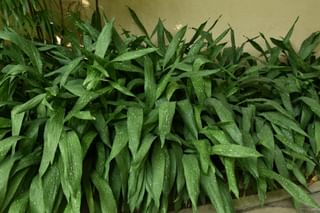
A Cast Iron Plant likes air with higher levels of humidity, but it can tolerate low humidity levels as well. However, while it can survive in dry air, making sure the humidity levels are at least 40% can help to grow the plant more quickly and keep it looking better.
The ideal humidity levels for a Cast Iron Plant are between 40% and 60%. You can maintain or increase humidity by spraying the leaves with water, misting it, using a humidifier, or grouping plants together to create a greenhouse environment. For more ways to increase the humidity levels, have a look at 10 ways to raise the humidity in your house.
What is the best soil for a Cast Iron Plant?
The Cast Iron plant is a plant that likes moist soil, so we'll need to use a potting soil mix that can hold onto moisture for a few days but also drains any excess moisture well. The best soil for a Cast Iron Plant is a potting mix that is made up of equal parts soil, peat moss, and perlite. This combination of ingredients allows water to drain quickly while still holding onto enough moisture to keep the plant's roots healthy.
The soil and the peat moss both hold onto moisture well but also provide the potting mix with structure. This structure is especially important for those plants that love moist soil because it prevents the soil from compacting over time. This keeps the soil nice and light, so the moisture can drain easily, but oxygen can also reach your plant's roots. The perlite is perfect for adding extra drainage to your soil and also provides extra structure.
Now it's time to see how and when to fertilize your Cast Iron Plant!
How do I fertilize a Cast Iron Plant?
During the growing season, spring and summer, when your cast iron plant is actively growing, it'll need some extra nutrients to grow. It grows slowly, so feeding it once per month with liquid fertilizer will give it enough energy to stay healthy during the growing period.
When you're applying the fertilizer, add it directly to the soil and make sure you don't get any on the leaves. Use only a diluted amount of fertilizer, as too much could burn your plant's roots. Keep in mind that during winter months, or if your Cast Iron Plant is not actively growing, fertilizing isn't necessary.
Remember that while providing your plant with nutrient-rich soil and regular fertilizing is important for its growth and health, too much of either can damage the plant. Always check on your Cast Iron Plant's growth and condition closely, being mindful of signs of overfertilizing such as burned leaves or yellowing foliage!
What type of fertilizer is best for a Cast Iron Plant?
If you want to give your cast iron plant the right fertilizer, use a balanced fertilizer with equal parts nitrogen, phosphorus, and potassium like 10-10-10 or 20-20-20. Make sure it's labeled as suitable for houseplants. Always follow the instructions on the packaging for your fertilizer to make sure you're giving your plant the right amount.
If you're wondering whether an organic of synthetic fertilzer is best for your plant, I have good news: They're both great! Just make sure to follow the directions on the packaging for the best results on your plant.
How do I trim a Cast Iron Plant?
Trimming your plants can be a little scary, but it's an important part of caring for them as it keeps them healthy. When you trim your plant, you're removing dead or damaged leaves from the plant. To do this, use a pair of sharp scissors or pruning shears and cut the leaf off at the base of the stem. Make sure the scissors or shears are clean, otherwise you risk spreading diseases or pests between your plants.
When trimming your cast iron plant, take care not to prune too much: just remove the damaged leaves and no more. Pruning away too many leaves can harm the plant's health. If you're looking to do major trimming, it's best to wait until the spring or summer to do this. This is the growing period of the year and your plant will recover much more quickly during this time.
You can trim dead, dry, or diseased leaves all year round. When you trim these leaves, you're not just making your plant look better, but you're also preventing pests from showing up. Pests love dead and decaying foliage.
How do I propagate a Cast Iron Plant?
The best way to get new plants for free is by propagating them. You can also do this for a Cast Iron Plant! The easiest way to propagate a Cast Iron Plant is propagation through division. Propagation by division means that you'll split the plant into several smaller plants. Usually, this means cutting a part of the plant off of the parent plant.
When your plant gets too big or starts to look overcrowded, you can divide it into new plants by digging up the entire plant and finding a part of the plant that has started growing its own roots. You can (carefully) cut this part of the plant from the parent plant and put this in its own pot. Be careful when untangling the roots, as these are quite fragile. It's important to keep most of the roots intact because this will increase your chance of successful propagation.
After you've planted your new plant in a pot, water it like you would normally. This "cutting" is now its own plant and needs to be watered and fertilized regularly.
How do I repot a Cast Iron Plant?
If you've kept your cast iron plant in the same pot for 2-3 years, you might notice its growth slows down. Your plant is probably rootbound and it's time to repot it. It's not difficult to do, but there are some steps you must follow to ensure you're taking care of your plant in the best possible way.
Gather supplies
Before repotting, make sure you have the necessary supplies on hand. You'll need potting soil (specifically for indoor plants), a new pot that is slightly larger than the current one, and some gardening gloves if you want to keep clean hands. You may also want to use scissors if your plant's roots have grown out of control.
If you're unsure about the best type of pot for your cast iron plant, I can highly recommend a terracotta plant as it allows the roots to breathe and provides good drainage. It also just looks really good, but that's personal taste.
Remove the plant from the pot
Once you've collected all your supplies, you can start by gently removing the plant from its current container. Gently massage its roots to loosen them from the pot. You can then lift your plant out of the pot with both hands. Once free, check for any dead leaves or overgrown foliage that can be trimmed away before moving on to repotting.
Place the plant in its new home
Fill the new pot with softened-up soil until it reaches about two-thirds of the way up the container. This will leave enough room for expansion as your plant grows bigger over time. Now carefully place your Cast Iron Plant into the new pot and fill in any gaps around its root system with additional soil. It's important to fill in any gaps in the soil, as water could get trapped here and this can cause root rot and damage your plant!
The last step of repotting your Cast Iron Plant is to water it and let it settle in in its new growing environment.
How long does a Cast Iron Plant live?
As we know by now, the Cast Iron Plant is an extremely hardy and resilient houseplant. It can survive low light and irregular watering schedules, making it a great choice for beginner plant enthusiasts! But one of the most impressive facts about this plant is its longevity. It has been known to live up to 50 years with the right care and growing conditions.
This makes it a great heirloom plant, as it can be passed down from generation to generation. It is also very resilient when it comes to temperature changes and occasional neglect; however, if you forget to water the Cast Iron Plant for too long or give it too much sun, its leaves may start to brown. To keep your Cast Iron Plant looking healthy, make sure that you're providing semi-regular watering (allowing the soil surface to dry in between) and indirect sunlight.
By taking care of this plant you can truly say that you can enjoy this plant for many years to come!
Can a Cast Iron Plant be grown outdoors?
A Cast Iron Plant is a very tough plant, so you might be wondering if you can bring them outside to keep in your garden. Whether you can bring your Cast Iron Plant outside really depends on the climate where you live. These amazing plants are native to eastern Asia (China, Japan, Taiwan), so they live in a subtropical climate. These plants love warm and humid summers.
If you want to bring your Cast Iron Plant outside, make sure it's in a climate that's not too cold or dry. In temperate climates like the US, the plant will die back in winter, but come alive again when it's warm. Find somewhere for it where it gets medium or shaded light during the day and then protect it from strong winds and cold temperatures at night.
If you've found the perfect spot for your Cast Iron Plant, you can enjoy it indoors and outdoors throughout the whole year.
How can I encourage flowering in a Cast Iron Plant?
Getting a Cast Iron Plant to flower can be tricky, especially indoors, but with the right care, you can boost your chances! Give it bright, indirect light and supplement with grow lights if needed. Keep the temperature between 15-24℃ and maintain moderate humidity with a humidifier or occasional misting. Water consistently, letting the top inch of soil dry out between waterings, and use a balanced fertilizer during the growing season.
Use well-draining soil with a slightly acidic to neutral pH, and repot every 2-3 years to refresh the soil and give roots more space. Regularly prune dead leaves and watch out for pests like spider mites. Flowering is rare and usually happens in older plants, so patience is key. Even if it doesn't bloom often, the lush green foliage makes it a great addition to your indoor garden!
Are there any common diseases that affect Cast Iron Plants?
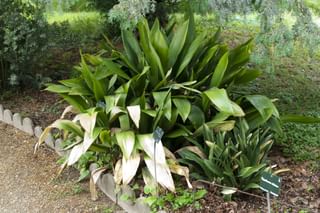
Cast Iron Plants can sometimes face common diseases, even though they're usually tough and resilient. Knowing about these issues can help you take steps to keep your plant healthy. The most common problems are root rot, leaf spot, anthracnose, powdery mildew, and southern blight.
Root rot
- Symptoms: Brown, mushy roots and yellowing leaves.
- Causes: Overwatering and poor drainage.
- Prevention and treatment: Make sure your pots have enough drainage holes, use well-draining soil, and only water when the top inch of soil is dry. If you spot root rot, take the plant out of its pot, trim the affected roots, and repot in fresh, well-draining soil.
For more information, have a look at How do you recognize root rot on your houseplant?.
Leaf spot
- Symptoms: Brown or black spots on the leaves.
- Causes: Fungal infections often happen because of high humidity and poor air circulation.
- Prevention and treatment: Try to avoid overhead watering, make sure there's good air circulation, and quickly remove any affected leaves. If the issue continues, you can always use a fungicide.
For more information, have a look at What is leaf spot disease on houseplants?.
Anthracnose
- Symptoms: Dark, sunken lesions on leaves.
- Causes: Fungal infection that spreads in wet conditions.
- Prevention and treatment: Get rid of infected leaves, try not to wet the leaves when watering, and make sure there's good air circulation. You can use fungicides if needed.
Powdery Mildew
- Symptoms: White, powdery substance on leaves.
- Causes: Fungal infection that thrives in humid, poorly ventilated areas.
- Prevention and treatment: Make sure there's good air circulation, lower the humidity, and use a fungicide that's made for powdery mildew.
For more information, have a look at What is powdery mildew on plants?.
Southern blight
- Symptoms: Wilting, yellowing leaves, and white mold at the soil line.
- Causes: Fungal disease in warm, moist conditions.
- Prevention and treatment: Remove and get rid of infected plants, improve soil drainage, and use the right fungicides. Keep the soil surface dry and don't over-mulch.
How do I deal with pests on a Cast Iron Plant?
Pests can be a real problem for any plant. The good news is that most pests are not attracted to the Cast Iron Plant, so you likely won't need to do much to get rid of them.
The most common pests that may affect this plant are aphids, whiteflies, mealybugs, and scales. If you notice these on your Cast Iron Plant it's important to take action quickly. To get rid of these bugs you'll want to use an insecticidal soap or an appropriate bug spray. These should help eliminate the bugs from your plant without causing too much damage.
If you don't feel comfortable using chemicals, there are some natural methods for dealing with pests as well. For example, you could get beneficial insects like ladybugs and put them on your plant. They will help to control the pests on your Cast Iron Plant. You can also make a homemade spray using ingredients like garlic and neem oil which can help deter certain types of pests from coming near your plants.
No matter how you decide to tackle the pest problem, it's important to take action quickly before it spreads too far. Once the pests are removed, be sure to keep an eye out for any new infestations and take action if necessary. With proper care and maintenance, these plants can thrive even in areas where pests might be an issue!
Is the Cast Iron Plant toxic for pets or children?
The Cast Iron Plant (Aspidistra elatior) is considered non-toxic to pets and small children. This makes it a safe choice for households with curious cats, dogs, or young kids who might come into contact with the plant.
While the plant is not toxic, it's still a good practice to supervise pets and children around any houseplant to prevent potential choking hazards or digestive issues from ingesting plant materials. Always ensure that your plants are placed in a location where they are out of reach of small hands and paws if necessary.
How do I revive a Cast Iron Plant that is dying?
User:Nino Barbieri, CC BY-SA 3.0, via Wikimedia Commons
Cast Iron Plants are hardy houseplants that can survive in difficult conditions. However, if your Cast Iron Plant is starting to look withered and droopy, it might need some help getting back to its vibrant self.
Check the soil
Luckily, bringing a Cast Iron Plant back to life is pretty easy with a few simple steps. First, check the soil's moisture level. These plants like their soil slightly moist but not soaking wet, as too much water can lead to root rot and kill the plant. If the soil is too wet or dry, just tweak your watering schedule to get it right.
Check the sunlight exposure
The next step is to ensure your Cast Iron Plant gets enough light. They like indirect light but handle low light better than bright sunlight, which can scorch their leaves. If you see dry or yellowing leaves, your plant might be getting too much sun and could use a shadier spot. Don't forget to trim the discolored leaves.
Look for pests
If your plant isn't suffering from any problems related to watering and sunlight, perhaps there are pests on your plant. By closely checking your plant, you can find out if there are pests and if so, which pests are attacking your plants.
If there are pests, take quick action to help get rid of the pests. Don't wait until an infestation becomes too large to control.
Check the humidity
Finally, make sure your plant has enough humidity to thrive - think rooms with high humidity like bathrooms or kitchens. Boost humidity by grouping your plants together, misting them regularly with a spray bottle, or getting a small humidifier to keep things nice and moist.
After completing these steps, you'll notice quickly that your plant is recovering and starting to look a lot healthier. Make sure to regulary care for your plant to help it recover more quickly.
Conclusion
The Cast Iron Plant is an incredibly hardy and resilient houseplant, capable of living up to 50 years with the right care. It loves warm and humid climates but can also survive in temperate areas if they're getting adequate light and humidity levels.
With the right care, such as regular watering schedules, indirect sunlight exposure, and occasional misting for added humidity, this plant will thrive for many years! So don't forget to share this guide with your friends and family so that they too can benefit from these tips on how to take care of their own Cast Iron Plant!
Thank you for reading this post! I hope it helps you to keep your plants healthy and beautiful! If you're looking for more guides on specific plants, you can always request a plant guide to get a guide for the plant you have trouble with.
Test your plant care knowledge
Quiz completed!
Want to learn more? Sign up for my newsletter to receive free tips in your inbox!
Sign up now!